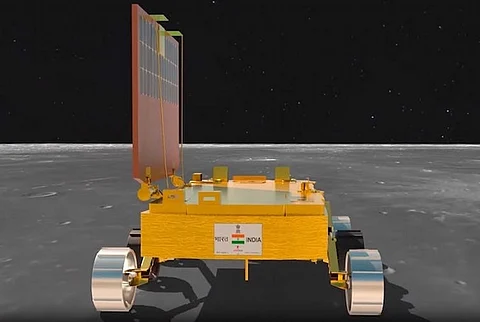

India's lunar rover began exploring the moon's surface on Thursday as part of the country's Chandrayaan-3 mission. New Delhi's Vikram lander reached the moon on Wednesday, making India the first country to land a craft on the lunar south pole.
The six-wheeled, solar-powered Pragyan rover will explore the largely unmapped area of the moon and transmit images and scientific data over a period of two weeks. It will examine the mineral composition of the moon's surface.
Chandrayaan-3 had to orbit the Earth several times to gain speed and took a month to reach the moon.
Chandrayaan-3 Mission:
— ISRO (@isro) August 24, 2023
Chandrayaan-3 ROVER:
Made in India
Made for the MOON!
The Ch-3 Rover ramped down from the Lander and
India took a walk on the moon !
More updates soon.#Chandrayaan_3#Ch3
The rover has two instruments that will conduct element and chemical composition experiments, ISRO chief S. Somanath said. He added that the rover would conduct a "robotic path planning exercise which is very important for us for future exploration."
The name, Pragyan, means "wisdom" in Sanskrit.
ISRO also issued images of the moon's surface taken after the landing. "Chandrayaan-3 chose a relatively flat region on the lunar surface," the organization said.
India's head of government declared that the mission would benefit all of humanity.
"Through the power of science, India is working towards a brighter future for all," Prime Minister Narendra Modi said. "India's strides in space will truly benefit humanity in the times to come."Feeling the fervour all the way from Johannesburg for Chandrayaan-3!
— Narendra Modi (@narendramodi) August 23, 2023
The enthusiasm of our diaspora in South Africa for India's achievements in the space sector is truly gladdening. pic.twitter.com/ApPdiQI9Fd
Modi also met with members of the Indian diaspora in South Africa on the sidelines of the BRIC summit of emerging countries to celebrate the successful landing.
"I once again congratulate the ISRO team and all fellow citizens for the successful deployment of Pragyan-rover from inside Vikram-lander," Indian President Droupadi Murmu said. "I look forward with excitement, alongside my fellow citizens and scientists to the information and analyses that Pragyan will acquire and enrich our understanding of the moon."
I once again congratulate the ISRO team and all fellow citizens for successful deployment of Pragyan-rover from inside Vikram-lander. Its rolling out a few hours after the landing of Vikram marked the success of yet another stage of Chandrayan 3. I look forward with excitement,…
— President of India (@rashtrapatibhvn) August 24, 2023
The landing came just days after a Russian lander crashed in the same region.
New Delhi has sought to lower costs for space missions by copying and adapting existing technologies. Chandrayaan-3 had a cost of $74.6 million (€68.8 million), which is far lower than most other countries' lunar missions.
Only the United States, China, and the former Soviet Union had previously achieved a controlled landing on the moon.
In 2014, India became the first country in Asia to put a craft into orbit around Mars. It also plans to send a probe towards the sun next month.
ISRO plans to launch a three-day crewed mission into the Earth's orbit by 2024.
In 2025, India is scheduled to launch a joint mission with Japan to the moon and an orbital mission to Venus.
Edited by: Richard Connor
This report was written in part with material from Agence France-Presse (AFP)
This article has been republished with permission from DW.com